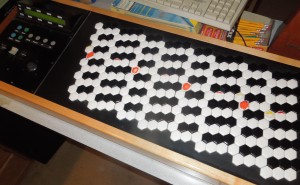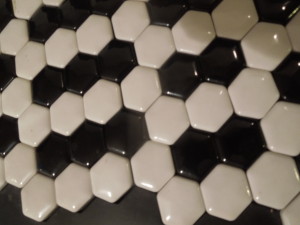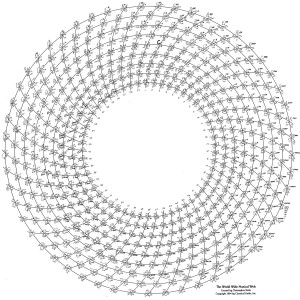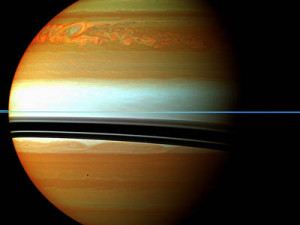Next Page: 2/2 – The Harmonic Series
My Journey to 53-equal
Do you know that our soul is composed of harmony? — Leonardo DaVinci
When I began composing at the age of ten, I sensed that everything I was playing was somehow “out of tune” to my ears. At the age of twelve I composed a Mass, and in it I asked that the singers intone notes halfway or a third of the way between two notes as they sound on a piano. The choir director refused to perform the work at the local Catholic Church I attended at that time, and told me those notes didn’t exist. I proved him wrong by singing the pitches I was asking for, but he continued to deny the existence of such notes!
In college, I had similar rejection. During the early 1970s, all the composition teachers I encountered were interested in teaching only Schoenberg’s dodecaphonic music. I was still looking for beauty and harmony, which resonated more deeply with my soul! As a result, I was told by professors that “No serious composer writes melodies any more.” “I teach only 12-tone music, nothing else. If you want to write tonal music, I have nothing to offer you.” “Your music, is… (nodding his head no).” As a result, I was, in essence, kicked out of four composition classes in two conservatories!
I kept composing anyway, relying mostly on my ear. But, with every recording or performance of my music, I drove my poor musicians crazy by constantly telling them that they sounded out of tune. So after composing, recording and releasing my music drama From the  Realm of the Shadow, I decided to study the laws of acoustics, harmony, and the roots of all music, in order to, once and for all have a grasp on what I was doing as a composer. I also wanted to know why everything sounded out of tune to me. My soul was composed of harmony but the world I lived in was not.
Realm of the Shadow, I decided to study the laws of acoustics, harmony, and the roots of all music, in order to, once and for all have a grasp on what I was doing as a composer. I also wanted to know why everything sounded out of tune to me. My soul was composed of harmony but the world I lived in was not.
In 1994, I met my spiritual teacher, Papaji, in India. The overwhelming experience of surrender into divine love became the inspiration for my upcoming major work, an oratorio called Melodies of the Shoreless Sea. In it I am setting poems celebrating union with The Divine from all around the world and throughout history. I read over 10,000 poems and collected a few dozen really great ones for this project. Gangaji takes the spoken role of Orator, commenting on these musical settings. But, all I could hear in my inner ear was music that was more harmonious than anything known in traditional music, in any genre. I knew that the ancients composed and performed music in scales that were fully in tune with the natural harmonics, and I decided I needed to write “in-tune” music. I wondered if it were possible to find a way to play music in all of these ancient tunings on a single instrument, using a single tuning system that would apply to all of them.
From 1999 to 2004 I took the tuning journey mostly alone, getting a few tips from composer Wendy Carlos and  microtonal guitarist Neil Haverstick. After reading Hermann Helmholtz’s classic book on acoustics and music, On the Sensations of Tone, I came to understand that if I used a tuning system of 53 notes to the octave, I could somehow play, sing and hear countless ancient scales in their original tunings. I also learned exactly how imprecise our standard tuning system really is. The prime-number natural harmonics that generate the unique notes of the perfect fifth, the major and minor thirds, and the “blues” sevenths, are represented in 12-eq by more and more crude approximations of the true harmonics as heard by the ancient cultures of the world. The natural overtones, which in their purest form were the basis of hundreds of ancient scales from every era and every continent, were the building blocks of scales that fairly sang in their purity and fidelity to the natural overtones.
microtonal guitarist Neil Haverstick. After reading Hermann Helmholtz’s classic book on acoustics and music, On the Sensations of Tone, I came to understand that if I used a tuning system of 53 notes to the octave, I could somehow play, sing and hear countless ancient scales in their original tunings. I also learned exactly how imprecise our standard tuning system really is. The prime-number natural harmonics that generate the unique notes of the perfect fifth, the major and minor thirds, and the “blues” sevenths, are represented in 12-eq by more and more crude approximations of the true harmonics as heard by the ancient cultures of the world. The natural overtones, which in their purest form were the basis of hundreds of ancient scales from every era and every continent, were the building blocks of scales that fairly sang in their purity and fidelity to the natural overtones.
For thousands of years, people from King Fang of China to Newton to Mercator to Helmholtz have known the mathematics of the 53-equal tuning system and its enormous potential. But they were unable to come up with ways to make it work practically. They all tried and gave up, because they did not have the technology to make it workable. In fact, editor and translator Alexander Ellis worked with the 53-equal pioneers of the nineteenth century, and in despair added this footnote to Helmholtz’s book: “Nothing short of the 53 division of the octave would suffice [to create the original natural harmonies]… and then musicians would have to learn how to use a practically just scale, and how to adapt tempered music to it, both of which present considerable difficulties. It is, therefore, safe to say that nothing of the kind will be done.” But the advent of computers is beginning to make it possible to deeply explore the potential of this exquisitely beautiful tuning system. I still haven’t found a perfect sequencer/notation program to do this, but we are getting close enough to this day that I believe it’s time to release version 1.0!
I collected over 300 ancient scales and their precise tunings from a number of sources. Most of the tunings were derived from the mathematical ratios that were used by music theorists of the time to describe their scales. Because of my limited experience in mathematics, I “hit a wall” where all I could do was collect more and more scales. I knew they all somehow fit into the 53-equal tuning, and by that time I had obtained an electronic “generalized keyboard” from Starrlabs in San Diego that could play 53 separate notes easily. With the help of my friend Scott Cleland I was able to create a computer system that could tune each note. But I couldn’t put it all together and understand how the notes all dovetailed and interacted with each other.


53 Figure 1-3a and b Starrlabs Keyboard
The Starrlabs generalized keyboard can play up to 72 separate notes per octave. The hexagonal keys are arranged in a honeycomb pattern and are designed to function as six regular piano keyboards on top of one another (see one octave of the row below, from C to C, with two black notes then three black notes, like a piano). I was searching for the Grand Unified Theory of Ancient Music. Some microtonal theorists (such as Wendy Carlos, Joe Monzo and Johnny Reinhard) already knew about this but were not composing much with it. They had gone on to more complex microtonal systems. I had always been attracted to Grand Unified Theories. I knew Steven Hawking was devoting his life to develop such a theory for the physical forces of the cosmos. Other thinkers and writers of our time had attempted the same thing in other realms: Stanislav Grof in realms of consciousness (Psychology of the Future), Ken Wilbur in philosophy (Up From Eden), Richard Tarnas in human history and cosmology (Cosmos and Psyche), Aldous Huxley in religion (The Perennial Philosophy); artists in all genres attempting to fuse cultural traditions and various religious movements seeking to bring forth the unifying truth of all the major religions, etc. Since 1945, humanity seems to have been searching with an ever-greater urgency for some kind of deeper union after the horrific divisiveness of two world wars. I too have always felt a great spiritual certainty that the cosmos is imbued with a profound underlying unity that can be discovered both through direct experience and through scientific study.
My first attempt to find a unifying principle in all of music was in my music drama, From the Realm of the Shadow. But the result was more of an eclectic sampling and a mixing of many musical styles. I did not dig deeply enough to find the meta-theory that united all the musical traditions. Then I discovered W.A. Mathieu’s great  theory textbook, Harmonic Experience. This was the first Grand Unified Theory of Music I had ever encountered, and in it he integrates the whole history of “tonal harmony from its natural origins to its modern expression.” Mathieu had extensively studied classical, jazz, and traditional music of India and Africa, and his theory book and compositions integrate all of these seemingly diverse elements. He is equally comfortable in the realms of 12-equal music and pure just intonation, and knows how to evoke the natural harmonics from the 12-equal system in common usage today. He likes 12-equal for its rich possibilities but he encourages his students to be able to sing in just intonation, what he calls the musical “Eden.” I can’t recommend this book highly enough. It inspired me to take 8 years of lessons from him, and much of what I know I owe to Allaudin Mathieu. Regarding the move from the ancient purity of just intonation to the modern, out-of-tune 12-eq system we have today, my teacher advises, “Forgive, but don’t forget.”
theory textbook, Harmonic Experience. This was the first Grand Unified Theory of Music I had ever encountered, and in it he integrates the whole history of “tonal harmony from its natural origins to its modern expression.” Mathieu had extensively studied classical, jazz, and traditional music of India and Africa, and his theory book and compositions integrate all of these seemingly diverse elements. He is equally comfortable in the realms of 12-equal music and pure just intonation, and knows how to evoke the natural harmonics from the 12-equal system in common usage today. He likes 12-equal for its rich possibilities but he encourages his students to be able to sing in just intonation, what he calls the musical “Eden.” I can’t recommend this book highly enough. It inspired me to take 8 years of lessons from him, and much of what I know I owe to Allaudin Mathieu. Regarding the move from the ancient purity of just intonation to the modern, out-of-tune 12-eq system we have today, my teacher advises, “Forgive, but don’t forget.”
That was a problem for me, because my ears could never “forgive” the fact that almost all music sounds (and is) out of tune. Mathieu’s book is a grand synthesis of modern 12-equal tuning, traditional music theory and its ancient origins. My book here has a different focus: to develop a musical template that allows considerably more harmonic richness than our traditional 12-equal tuning while staying in tune. I promise you, if you can read and understand Mathieu’s book, it will greatly enrich your understanding of the potential of 53-equal music.
At first I couldn’t put the math together on my own. Five years after starting my work, one early morning in February of 2004 I was in despair. My floor was strewn with papers covered with ratios and numbers and scales and mathematical stuff. I remember taking a big exhale, and as I looked at the floor, it was as if hundreds of grey “dead numbers” were lying around everywhere. Suddenly they all lit up, each number a numinous, blazing, living force. They shot up into the air, forming nine concentric circles, all exquisitely interconnected. Each number was now its own energy source, no longer represented by the symbols 1, 2, 3 etc. They were all interconnected, with numbers most closely related to each other next to one another. The vision lasted only two or three minutes, but suddenly I completely understood the mathematical connections among so many ancient scales, and I was able to draw a large musical mandala (the one I saw in my vision, but now with the written numbers and letters at the line intersections which the illuminated pitches and ratios represented).
 I spent the next four months calculating all the notes and numbers and creating the mandala, but at every moment I knew exactly where I was, guided by the vision that fully oriented me every step of the way. Though I was not the first person to do this, I had finally internalized and fully understood for myself the meta-theory that was the underpinning of countless musical systems of many of the ancient cultures of the world. With my understanding, my computer programs and my honeycombed keyboard, I could at last create music wherein scales from ancient Japan, China, India, Arabia, Turkey, Greece, Rome, Byzantium, Egypt, Tunisia and many more could all be played in a single piece, on a single instrument, their underlying harmonic similarities bringing them into a perfect union. I felt as Galileo may have felt with the world’s first telescope. Wherever he pointed his instrument, he would discover literally thousands of stars no one had ever seen before. So it is with 53-eq music: everywhere I look I see new musical potentials, new scales, new modes of expression that could keep thousands of the most innovative composers happy for countless centuries.
I spent the next four months calculating all the notes and numbers and creating the mandala, but at every moment I knew exactly where I was, guided by the vision that fully oriented me every step of the way. Though I was not the first person to do this, I had finally internalized and fully understood for myself the meta-theory that was the underpinning of countless musical systems of many of the ancient cultures of the world. With my understanding, my computer programs and my honeycombed keyboard, I could at last create music wherein scales from ancient Japan, China, India, Arabia, Turkey, Greece, Rome, Byzantium, Egypt, Tunisia and many more could all be played in a single piece, on a single instrument, their underlying harmonic similarities bringing them into a perfect union. I felt as Galileo may have felt with the world’s first telescope. Wherever he pointed his instrument, he would discover literally thousands of stars no one had ever seen before. So it is with 53-eq music: everywhere I look I see new musical potentials, new scales, new modes of expression that could keep thousands of the most innovative composers happy for countless centuries.
As I began to play some of these lost, ancient scales in their pure, original tunings, I sometimes wept for joy. It is as if sleeping giants were being roused from their slumbers and allowed to sing once again. But now there is a new way they can express themselves. In most ancient cultures, flutes and other instruments could play only seven or at most twelve different notes. These notes would be carefully tuned to the harmonic ratios determined by the fixed scales. And they were developed in societies with very fixed caste systems of one kind or another. The advanced ancient civilizations all had a class of people who had the time to study mathematics and the cosmos. Their studies brought them the engineering principles that allowed the creation of pyramids and other monolithic structures on every continent, complex astrological systems, advanced weapons of war, full-scale city planning, and an understanding of the mathematical principles of acoustics underlying all music. But every ancient musical system was fixed in a single “key.” If an ancient mode started in F, by God it ended in F, and there was almost no such thing as a key change. There is a static quality to much of ancient music which reflects perfectly a spiritual connection to some core presence around which the entire cosmos dances and sings in praise– but it also exposes the static quality of their societies.
For westerners, modulation (changing keys) is about transformation, exploration– and it reflects well the cultural imperative of western civilization for expansion, change, intellectual complexity and improvement. Western European composers developed one tuning system after another to facilitate greater complexity and transformation in the music they wrote. In doing so, they made bigger and bigger compromises with the purity of sound they inherited from the ancient Catholic Church and ancient Greece. By the early 1800s, pianos were being tuned to twelve logarithmically equal pitches, smoothing out any differences between scales, and doing audible violence to the uneven musical intervals which appear in modes built on the natural harmonics. As Western Europeans conquered and colonized the rest of the world, they also colonized their musical traditions, bringing their 12-equal tunings with them. Gradually the ancient tunings began to die out as musicians from around most of the world traded being in tune for being up-to-date. There remain pockets of musical traditions that preserve the ancient tunings, but they are in a clear minority today.
Employing 53-equal tuning means I can revel in the purity of the ancient scales while opening new doors for incredible complexity and harmonic richness. My western mind and my natural pitch sensibilities are both given
expression. My compositions can unify the harmoniousness of hundreds of ancient scales and the transformational power of the Western European musical tradition. I can approach each ancient scale on its own terms, playing it precisely as it was heard hundreds or even thousands of years ago. I can also create modulations and blends of these scales, finding the common thread of harmonic purity that unites scales and modes from all over the world. In this way, they can discover one another and sing together in an earthly harmony unknown to us until now. The best of both worlds unite into a single system which embraces the deeply expressive power of hundreds of ancient scales, allowing them to move and dance freely through the musical universe.
You may have another reason to explore 53-equal. To deeply understand the harmonic origins of our Western musical system, you may wish to read and study Harmonic Experience by Allaudin Mathieu and remain with 12-eq for your compositions. Then, you may want to read this book and actually set up a 53-eq tuning system in order to hear what Allaudin Mathieu is describing in his book. This book will also help you develop an understanding of the deep interconnectedness of all of the music of the world. We will go on a journey around the world and touch upon the hundreds of scales and dozens of musical traditions of many ancient cultures, as well as take a ride into the future as we explore septimal harmonies (built off the seventh harmonic), 53-eq atonality, and many other topics not covered in Mathieu’s book. This book can be studied on its own, but it also rides piggyback on Mathieu’s book, and between these two books you will be able to plumb the deepest mysteries of music and understand its true source like very few other musicians and composers ever will.
The move to 53 notes to the octave will not be embraced by most musicians. It’s too hard. But it’s the most ecological way I know of to discover what the all the ancient scales actually sounded like, keeping their harmonic integrity intact and not polluting the air with unnatural dissonances. We were trained to tolerate the inharmonicity of 12-eq, but being out of tune degrades the core acoustical principles of our progenitors. We approach the ancients not as colonizers who destroy their ancient ways, but as musical pilgrims who learn from and absorb the lessons of our sonic travels. Yes, there is a simple principle that unites much of music. And that principle has been known by people for countless centuries. I did not discover the 53-equal tuning system, but as far as I know I am one of the only people to have devoted years to bringing it forth to blossom. Microtonalists know about 53-equal as one of many tuning systems they pursue. Most of them “jump over” it as they explore ever more complex and new musical systems. I hope that my initial work in this area will be like a gold miner who points to the Mother Lode with a simple pickaxe, and tells the world that there are veins of gold spreading in every direction to be discovered for centuries to come. If I’m very lucky, I may someday inspire a truly great composer to explore expressive possibilities I could never have imagined. No, it is not, strictly speaking, a “Grand Unified Theory.” Not every culture builds their scales and musical instruments off the harmonic series. But this theory does indeed unify much of what ancient music theorists around the world have created into a powerful metatheory.
The “Ah-ha” moment in science is often the revelation of a simple unifying principle that unites data collected from observing a lot of phenomena. My 53-eq journey is a process of solving the riddle of the cosmos as it manifests in music. I don’t know how others feel when they discover or figure out some unifying principle that brings disparate things in the universe together, but what I felt was love.
By the way, one day I realized that I was born in 1953 and that my home phone number for the first 18 years of my life was 729-4353. My wife is 5’3″ tall. The west Denver home where I live today is exactly 5353 feet above sea level. My astrologically inclined friends will be interested to know that Saturn, the planet of difficulty, has 53 moons.
A free introduction to what The Grand Unified Theory of Music offers is on this website and includes both text and a few musical examples from each webpage. If you would like to learn more about this chapter and the full contents of this entire e-book, you can buy The Grand Unified Theory of Music for $25, with hundreds of embedded musical examples of scales and chords from all over the world — and ideas for how to set up your computer system —
HERE.
You’ll get a personalized password you can use to see the entire e-book. Inside the full book, you will also get a link to the complete pdf file of this e-book, which you can read on your Kindle or similar device. The links to the hundreds of mp3 sound files – the same ones you can hear on the website — will also be included. This is “Version 1.0” of The Grand Unified Theory of Music. Because it is an e-book, additions, corrections and improvements in the sound may be added at any time. The Grand Unified Theory of Music is Copyright © 2018 by Christopher Mohr. All rights reserved.
One person per password. Sharing this password with others is a violation of copyright. Do not allow others to use your password or link to the pdf file!


